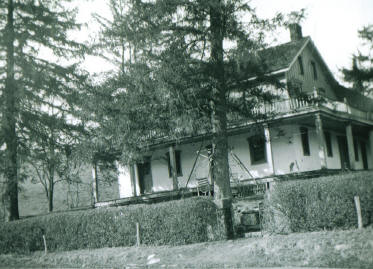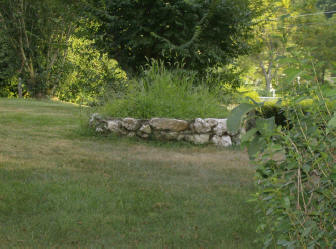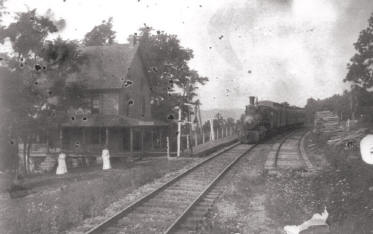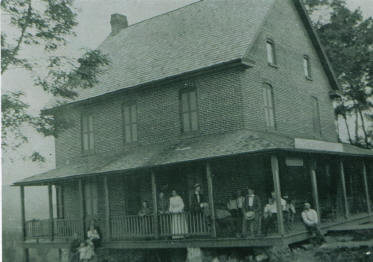|
A Brief
History of Fountaindale
& It's Post Office
Paul E.
Seabrook
(Submitted by
Howard and Jane Cline of Fountaindale)
Many interesting things come to
light when we inquire into how and why some of our Post Offices
were named. Following is a brief story of how Fountaindale was so
named.
In order to make clear the circumstances that led to this name
being chosen for the Post Office in this locality it will be
necessary to give some of the early history of the hamlet which is
located about midway of the valley of Miney Branch Creek in the
extreme south western part of Adams County, Pennsylvania.
This stream flows between Jacks Mountain on the north and Raven
Rock mountain on the south and has its source in Charmain Springs
just across the Franklin County line, near
Monterey, and empties into Toms Creek at
Zora.
Among the early settlers, in alphabetical order, were the names
of Gordon, Gourley, Buhrman, Flohr, Beard, Harbaugh, McIntyre,
Sprenkle and many others.
About 1785, Daniel Sprenkle, who came form Manchester Township,
York County, (Adams County was then still part of York County),
obtained a grant of 444 acres of land from the Honorable Penn
Grantors, in Hamilton Bann Township. This tract extended from the
"Great Road" as its southern border, to high on the southern slope
of Jacks Mountain. When the first census was taken, after Adams
County became separated from York County in 1800, the census shows
that Daniel Sprinkle (Sprenkle) owned land valued for taxation at
$1284.00 and on which there was saw mill, valued at $300.00.
When Daniel died in 1822, being weak and sick of body, but
strong of mind, he directed in his will that his "Plantation" be
divided along the west side of his orchard, beginning at the old
"Great Road" and the eastern portion be sold. At the time of his
death his new stone farm house was not completed.
His two eldest sons, Daniel and William, acting as his
executers in compliance with his will, sold the eastern portion to
Joseph Baugher, who established a tannery in a small meadow along
the creek, built an elaborate home with a fountain in the front
yard. The water for the fountain being piped from the mill race
which was some 300 feet to the rear of the house and some 10 feet
above the level of the front yard. This was the saw mill that
Daniel had built. Why he wished this part of his land to be sold
has remained a mystery to this day.
On a small tract of this land, at the intersection of the
""Great Road"" with the road that came up through the valley, was
established the first Lutheran Church in this part of the county,
it being part of the
Emmitsburg, Maryland charge. The ""Great Road"" came over the
edge of Jacks mountain form Gettysburg, this part is now known as
the Jacks Mountain Road.
Here also was the Gordon's Tavern, later knows as Walkers, and
other saw mills down stream. This settlement was sometimes known
as "Baugher's Dale".
|

Stage Coach Stop and
Boarding House. 17 Bedrooms and Civil War Soldiers stopped
here during the retreat from Gettysburg. Photo about 1900
Frederick and Lydia McIntire.

the Fountain in front of the Fountaindale
Springs House
|
When the Post Office was established in 1837, Mr. Joseph
Baugher was chosen as the post mater and "Fountaindale" was
selected as the name because of the fountain in his front yard.
Mr. Baugher served as post master until 1845, when Reuben Steen
(Stem) was appointed to the post.
History does not show why the change was made, but if we
examine the record of politics at Washington, we see that this was
a time of turmoil, William H. Harrison, a Whig, had died after
only one month in office and the Vice President, John Tyler, a
Democrat, had altogether opposite views, also the Nation was
undergoing a financial panic, all of which may have had some
influence in the remote parts of the country. Mr. Stem served
until 1849, when the office was closed for some reason.
Available records do not show at what time it was reopened, but
Mr. Stem was again appointed. Later Mr. Daniel Martin was
appointed postmaster and he continued to serve until it was closed
in 1902. At that time the Rural Free Delivery began to serve the
community from the Post Office at Fairfield.
It might be well to note here that some time later Mr.
Frederick McIntire set up a fountain in his front yard about a
half mile farther down stream and named it "Fountaindale Spring".
This name appears on old maps of the County and causes some
confusion as to the actual location of the first fountain.
When the Mercersburg, Greencastle and Waynesboro Turnpike was
built through this valley a great deal of the old ""Great Road"" was
abandoned, only small portions of it now serve as farm lanes or
access roads to outlying fields.
This road served as the boundary line between Hamilton Bann and
Liberty townships from its junction with the road from Emmitsburg
to its junction with the Harbaugh Valley Road, at this point the
line jogs northward to the creek and continues westward to the
Franklin County line.
The last location of the Fountaindale Post Office was in Mr.
Daniel Martin's store, at the junction of the turnpike and the
Harbaugh Valley Road.
The Lutheran Church merged with a new church that was
established in Fairfield in 1855. This new church was also served
from the Emmitsburg, Maryland charge. Mr. Aaron Musselman, a
trustee of the new church was delegated to dispose of the log
building.
What was done with it is not recorded, but the stones of the
foundation went into the foundation walls of a new home that was
built for Mrs. Emma Walker, widow of Horace Walker, in 1908.
(Diary of Edgar A. Sprenkle, who was the contractor, 1908).
This house is only a short distance form the old church yard.
Only a few fallen stones remain today of the pioneers who were
buried here, most of them being destroyed by vandals. One small
lot which has a dry stone wall around was undisturbed, showing
that the vandals favored it for family reasons.
The land and other property of Joseph Baugher passed into the
ownership of Sanford Schroder, who continued to operate the
tannery and saw mill.
Mr.
Schroder was taken prisoner by General Stuart when he made a raid
through this section during the Civil War. Mr. Schroder
and a small son were riding in a cart when they were overtaken by
the rebels; They put a worn out horse in the shafts of the cart
and allowed the boy to go home, but took the father along and the
good horse. John Martin was also taken prisoner at this time. The
story says that he was working in a field near the road when the
rebels came along. He defied them and said uncomplimentary words
to them and got taken along for his patriotism.
As he was being taken away he called back to his relatives to
tell his mother that her warning that the devil would get him if
he did not mend his ways had come true; "Now the devil has me,"
why he was not shot at once remains a mystery.
All the finished leather was taken from the Schroder tannery at
this time as this was of great importance to the rebels.
When General Lee camped in this valley on the first night of
his
retreat from the battle of Gettysburg, a badly wounded
rebel soldier died and was buried in the old Lutheran cemetery.
This writer often looked at the small marble marker which lay
by itself at some distance from any other markers, but did not
make a record of the inscription. The name is lost to memory; it
read in part, Died, July 4, 1863. Aged 20 Years.
Mr. Schroder was released from prison near the end of the war,
along with his friends and neighbors, all were in bad condition
from starvation and sickness and some had to be carried by their
stronger companions. He was never ale to recover fully from this
ordeal but tried to carry on for some years afterward and to
rebuild the tanning business. The saw mill fell into disrepair and
to add to his troubles the home built by Joseph Baugher burned and
the Schroders had to move into a small log house at the edge of
the tannery.
In the late 1880's he sold the land to William J. Sprenkle, a
grandson of the original owner and a son of William Sprenkle , one
of the executers of Daniel's estate. The old saw mill was in bad
condition and after it had been sold to Mr. Sprenkle. The Schroder
boys took the cast iron gearing out of the mill and hauled it to
Waynesboro, 10 miles away, where it was sold to the Geiser Co. as
junk. When this was discovered by the new owner, he began a search
for the missing machinery and found it at the Geiser plant, but
decided to take no action, due to the decayed condition of the
whole structure, which he demolished and replaced with a complete
saw mill and building bought from A. Flemington White, along
Middle Creek. A small grist mill, with stone burrs was added to
the saw mill and the wooden over shot water wheel was replaced by
turbine wheels. This saw mill was of the type known as the "sash".
In this type the saw blade was held in a large frame that was wide
enough for the carriage that carried the log, to pass through. The
saw being held under tension in the center of the "sash" somewhat
like the hand operated jig saw used by wagon makers to saw the
curved parts of the wagon.
When William J. died in 1892, a son Edgar A. Sprenkle came into
possession of the land which at that time consisted of 162 acres
and 80 perches. In 1894 he built a new home near the site of the
one that had burned. A new barn that burned before it was
completed and replaced it with a smaller one. The fountain was
removed and all traces of it are gone. Since his death in 1915 the
land has been sold and divided into many smaller portions. The old
mill is gone and not much remains but the huge stone dam that
stands as a memorial to the engineering ability of the pioneer
forefathers. This dam replaced the original earth and log dam
built by Daniel Sprenkle and which had washed out after it was
sold to Joseph Baugher. The new dam was built farther up stream.
|

Jacks Mountain Station House was built in
the 1880's by William (Bennie) Heyser on 253 acre orchard &
farm.

close up of the house in the late 1880's. |
When the Rail Road was built from Gettysburg to meet the
existing Rail Road at Highfield, (now the Western Maryland), the
section which is on Jacks Mountain was built in 1889, the mails
were carried by train and the post between York and Hagerstown was
discontinued.
The mail for the Fountaindale Post Office was dropped off at a
point along the track just above the store, which was reached by a
foot path, and mail was picked up by suspending the bag by top and
bottom from two arms fastened to a pole along side the track, a
hook was extended from the mail car, which caught the mail sack
and pulled it into the car, trains did not stop at this point. It
was the duty of one person to carry the sack up and place it on
the pole and bring down the sack with the incoming mail. There
were four trains each week day which made it necessary to make
four trips each day by the foot path. This was not the duty of the
Postmaster, but was done by some one who was not very much
occupied otherwise.
Many new post offices were established after the Rail Road was
built. Some of the nearby were Virginia Mills, Iron Springs, Jacks
Mountain, Gladhill, (now Greenstone) Charmain; All of these served
the small community near by and most have now been discontinued.
The tavern at the original location of the Fountaindale Post
Office, was built and operated by the Gordons. It was built of
logs and the bed rooms were very small. Dr. Sidneyham C. Walker,
who came from Dakota Territory, married one of the Gordon
daughters and later became owner and operator of the tavern.
Dr. Walker served with the Union Army during the Civil War and
was away from home at the time Lee camped in this valley on his
retreat from the battle of Gettysburg. Dr. Walker had a son
Horace, who married Emma Martin. They had two children.
When Dr. Walker died in 1902, he willed his property to his two
grandchildren, the granddaughter getting the portion on which the
buildings stood and the grandson the land on the opposite side of
the Turnpike, on this land had been a saw mill, which had burned
and was never rebuilt. Here also had been a log school
house, known as "Walker's". This school was in Liberty
Township. About 1883 a new brick school known as Miney
Branch was built farther down stream and the old log building was
sold to George Sprenkle and was moved about 1/2 mile away at the
foot of Jacks Mountain and set up as a home, at the time of this
writing it is still there and in good condition. Mr. Charles
G. Flohr told this writer that his father Mr. John Flohr had let
him have a team of four horses and wagon to haul the old school to
its new location.
There were many other saw mills along this stream in the early
days, on the Flohr land, and farther up stream the pioneer
Harbaugh family had built a large brick flour and feed mill and a
saw mill. Later this was bought by the Martins and operated
by them for many years. This mill stood at the junction of
the old "Great Road" and the Harbaugh Valley Road. In
1923 it was sold to the new First National Bank & Trust Co. of
Waynesboro, Pennsylvania. The building was demolished with
dynamite and the bricks used in the rear walls of the new bank
building on the northwest corner of the Waynesboro square, where
they can be seen today. All of the gearing, pulleys and
shafting in this mill were made of wood and the grain was ground
by stone burrs.
When the Mercersburg, Greencastle and Waynesboro Turnpike was
built through this valley, it cut through the churchyard of the
Lutheran Church and the eastern portion came into possession the
Schroders and later the Sprenkles. After some time Mr. Edgar
Sprenkle built a small home for his aged mother on this land using
what was useful of the old house at the edge of the tan-yard where
the Schroders had last lived.
Some years ago this writer went to the old churchyard to try to
locate the grave marker of the Confederate soldier and record the
inscription, but it was no longer there. Also gone were the
stones that marked the graves of Daniel Sprenkle and his wife, but
the markers of their daughter and her husband, Jacob Stover were
there as well as the walled lot of the Hardman family. All of the
other markers had disappeared, perhaps carried off by some of the
workers when the new "Sunshine Trail" was built.
When the Lutherans began to die out, the Methodists became the
stronger and the new Wesley Chapel became the center of activity
in Fountaindale, with the store and post office nearby and later
Mr. John Barton set up his blacksmith and wagon shop and store,
just next door to the church.
A short distance away, in Harbaugh's Valley were St. Jacobs
Reformed Church, the Brethren (Dunker) Church and the "Valley"
school. This building now belongs to St. Jacobs Church.
The Brethren Church was sold, turned into a home and some years
ago burned. Once the members of this faith were very
numerous in this section, but few if any are left.
The old Fountaindale school house was a stone building about
midway between the first and last post offices. A new frame
building was built farther west and the old stone building was
eventually torn down and the stones used in the foundation walls
of a new home built by Mr. Clarence Sprenkle, a great-great
grandson of the pioneer, Daniel.
At Fountaindale Spring, Mr. Fred McIntire built an addition to
his home and established a small tavern, a spring on a hill to the
rear supplied water to the fountain and to the house and here it
can be safely said was the first bathroom in this community.
This fountain has long since disappeared, as well as the original
one put in by Joseph Baugher.
When the railroad was built in 1889, the workmen had a building
on the partly finished embankment of the old "Tape-worm Railroad"
in which they ate and slept. These workmen were known as
"Hunkies" and could not speak much English. These workmen
would come down to the Sprenkle mill pond to fish and someone told
them that if they would set off a charge of dynamite in the pond
they would get plenty of fish. This was attempted but the
fuse was too long and the water carried the charge under the dam
where the water flowed into the mill race. Here it exploded
and badly damaged that part of the dam. When the owner
discovered the damage, he began to look for the culprit, and
finding who was responsible, let him off at the large sum of
$5.00. An old steam engine boiler was bought, the ends cut
out and it was turned upside down in the breach and stones filled
in around it. Here it can be seen today if anyone will crawl
into the opening where once the water flowed through.
So many changes have taken place in this little valley that if
any of the pioneers could return to walk through it, they would be
amazed to see what has taken place. Automobiles and heavy
trucks zoom up and down the mountain where once horses labored
hard to haul a small portion of the weight carried today.
And under Raven Rock Mountain, which was once known in part as the
Beard lot, is the Underground pentagon, and farther up are the
mills for manufacturing roofing granules, commonly known as
"grit". Much of this area is underlain with a very hard
green copper bearing rock that is used for the "grit".
About the turn of the 20th century an attempt was made to
develop the copper mining industry and a smelter was built and
operated for a few years, but although copper was there, it was
not of a profitable quantity and the effort was a failure.
Many people who put their money into this venture went bankrupt
and some of the promoters thought it wise to depart for a more
healthy climate.
When later it was discovered that this same green rock could be
used for the roofing granules, two separate industries put up
mills and were very successful but the waste dust and fine sand
was dumped into the creek and flood waters carried to the old mill
ponds completely filling them and in some places changed the
course of the stream, causing it to flood meadows and making it
entirely useless for fish and other wildlife.
The writer had a good deal of litigation with the management of
these grit mills about the deposit and the damage done by the fine
sands carried into the turbine wheels of the mill, this acted like
a sand blast and cut the bearings and shafts, making expensive
repairs a frequent necessity.
Little was accomplished as the mills had foreseen what would be
the result and had strategically retained all the lawyers in the
County. Promises were made to stop the dumping, but never
kept. Those who did succeed in getting a damage suit before
the court were promptly quashed with a nominal settlement.
When this story was begun it was intended to give only an
outline of the origin of the Post Office, but many other items
seemed to be part of the story and it kept enlarging. It is
not intended to give any one family the center of the stage or to
put another into the background, but to use all who were a part of
the early history.
If anyone who reads these pages can add any authentic item, it
will be most welcome, as no one person, even when they have an
unusual collection of old documents, personal papers of former
generations and access to early history, can put the complete 100
percent story together.
It appears that John Martin was appointed Postmaster after his
return from prison for he resigned in 1866 and Samuel Martin was
appointed in his place Fountaindale post office. (March 1966
100 years ago item in Gettysburg Times).
Have your own memories of
growing up in Fountaindale?
If so, send them to us at
Hisotry@emmitsburg.net
Back
to Previous Page >
|